

Compact Muon Solenoid
LHC, CERN
| CMS-TOP-13-017 ; CERN-EP-2016-208 | ||
| Search for top quark decays via Higgs-boson-mediated flavor-changing neutral currents in pp collisions at $ \sqrt{s} = $ 8 TeV | ||
| CMS Collaboration | ||
| 16 October 2016 | ||
| JHEP 02 (2017) 079 | ||
| Abstract: A search is performed for Higgs-boson-mediated flavor-changing neutral currents in the decays of top quarks. The search is based on proton-proton collision data corresponding to an integrated luminosity of 19.7 fb$^{-1}$ at a center-of-mass energy of 8 TeV collected with the CMS detector at the LHC. Events in which a top quark pair is produced with one top quark decaying into a charm or up quark and a Higgs boson (H), and the other top quark decaying into a bottom quark and a W boson are selected. The Higgs boson in these events is assumed to subsequently decay into either dibosons or difermions. No significant excess is observed above the expected standard model background, and an upper limit at the 95% confidence level is set on the branching fraction $\mathcal{B} ({\rm t \to Hc} )$ of 0.40% and $\mathcal{B}({\rm t \to Hu})$ of 0.55%, where the expected upper limits are 0.43% and 0.40%, respectively. These results correspond to upper limits on the square of the flavor-changing Higgs boson Yukawa couplings $|\lambda_{\rm tc}^{\mathrm{H}}|^{2} < 6.9\times 10^{-3}$ and $|\lambda_{\rm tu}^{\mathrm{H}}|^{2} < 9.8 \times 10^{-3}$. | ||
| Links: e-print arXiv:1610.04857 [hep-ex] (PDF) ; CDS record ; inSPIRE record ; CADI line (restricted) ; | ||
| Figures | |

png pdf |
Figure 1:
Trilepton invariant mass versus opposite-sign dilepton invariant mass in the trilepton channel after the event selection described in Section 3 for simulated signal, estimated background, and data, from left to right. |

png pdf |
Figure 2:
Jet multiplicity in the samples featuring three identified leptons (left) and two SS leptons (right) after rejecting events with Z bosons. The data are represented by the points with vertical bars, and the unfilled histogram shows the expected signal assuming $\mathcal {B}({\rm t\to Hc})$ is equal to 3%. The dominant backgrounds are represented with filled histograms and the background (BG) uncertainty is shown as shaded bands. |

png pdf |
Figure 2-a:
Jet multiplicity in the samples featuring three identified leptons after rejecting events with Z bosons. The data are represented by the points with vertical bars, and the unfilled histogram shows the expected signal assuming $\mathcal {B}({\rm t\to Hc})$ is equal to 3%. The dominant backgrounds are represented with filled histograms and the background (BG) uncertainty is shown as shaded bands. |

png pdf |
Figure 2-b:
Jet multiplicity in the samples featuring two SS leptons after rejecting events with Z bosons. The data are represented by the points with vertical bars, and the unfilled histogram shows the expected signal assuming $\mathcal {B}({\rm t\to Hc})$ is equal to 3%. The dominant backgrounds are represented with filled histograms and the background (BG) uncertainty is shown as shaded bands. |
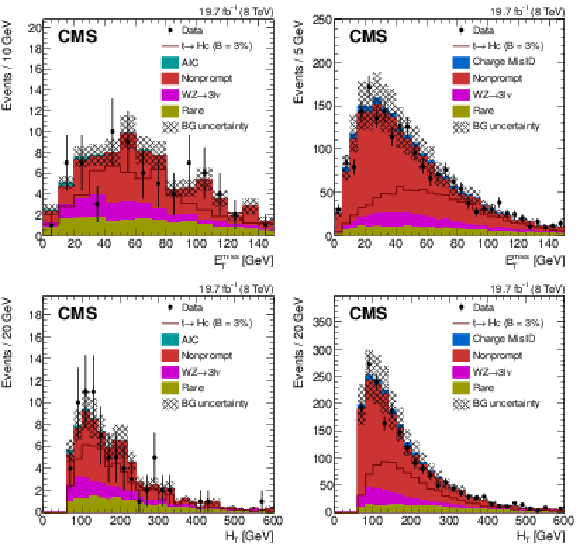
png pdf |
Figure 3:
The ${E_{\mathrm {T}}^{\text {miss}}}$ (top) and ${H_{\mathrm {T}}}$ (bottom) distributions in the trilepton (left) and SS dilepton (right) channels in data (points with bars) and predicted by the SM background simulations (filled histograms) after rejecting events containing Z bosons, requiring at least two jets, and the event selection described in Section 3. The overall background uncertainty is shown in shaded black. The expected signal assuming a $\mathcal {B}({\rm t\to Hc})$ of 3% is shown by the unfilled histogram. |

png pdf |
Figure 3-a:
The ${E_{\mathrm {T}}^{\text {miss}}}$ distribution in the trilepton channel in data (points with bars) and predicted by the SM background simulations (filled histograms) after rejecting events containing Z bosons, requiring at least two jets, and the event selection described in Section 3. The overall background uncertainty is shown in shaded black. The expected signal assuming a $\mathcal {B}({\rm t\to Hc})$ of 3% is shown by the unfilled histogram. |
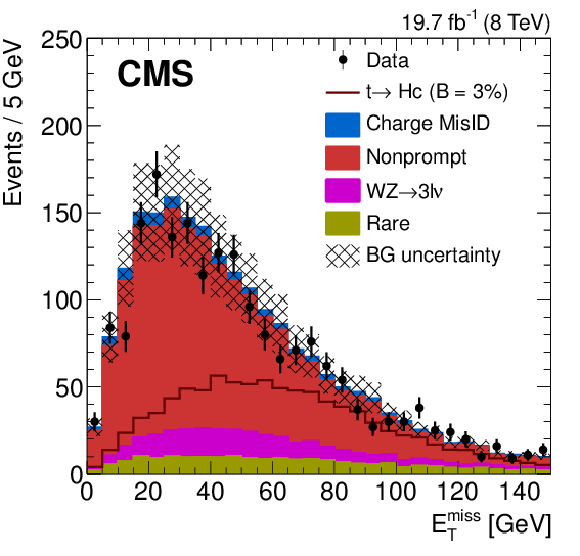
png pdf |
Figure 3-b:
The ${E_{\mathrm {T}}^{\text {miss}}}$ distribution in the SS dilepton channel in data (points with bars) and predicted by the SM background simulations (filled histograms) after rejecting events containing Z bosons, requiring at least two jets, and the event selection described in Section 3. The overall background uncertainty is shown in shaded black. The expected signal assuming a $\mathcal {B}({\rm t\to Hc})$ of 3% is shown by the unfilled histogram. |

png pdf |
Figure 3-c:
The ${H_{\mathrm {T}}}$ distribution in the trilepton channel in data (points with bars) and predicted by the SM background simulations (filled histograms) after rejecting events containing Z bosons, requiring at least two jets, and the event selection described in Section 3. The overall background uncertainty is shown in shaded black. The expected signal assuming a $\mathcal {B}({\rm t\to Hc})$ of 3% is shown by the unfilled histogram. |

png pdf |
Figure 3-d:
The ${H_{\mathrm {T}}}$ distribution in the SS dilepton channel in data (points with bars) and predicted by the SM background simulations (filled histograms) after rejecting events containing Z bosons, requiring at least two jets, and the event selection described in Section 3. The overall background uncertainty is shown in shaded black. The expected signal assuming a $\mathcal {B}({\rm t\to Hc})$ of 3% is shown by the unfilled histogram. |

png pdf |
Figure 4:
The $m_{\gamma \gamma }$ distribution and the fit result of the hadronic (left) and leptonic (right) channels. The dashed line represents the component of the nonresonant diphoton background, while the solid line represents the total background plus signal. The shaded bands represent one and two standard deviation uncertainties of the fit. |

png pdf |
Figure 4-a:
The $m_{\gamma \gamma }$ distribution and the fit result of the hadronic channel. The dashed line represents the component of the nonresonant diphoton background, while the solid line represents the total background plus signal. The shaded bands represent one and two standard deviation uncertainties of the fit. |

png pdf |
Figure 4-b:
The $m_{\gamma \gamma }$ distribution and the fit result of the leptonic channel. The dashed line represents the component of the nonresonant diphoton background, while the solid line represents the total background plus signal. The shaded bands represent one and two standard deviation uncertainties of the fit. |

png pdf |
Figure 5:
Comparison between data and simulated events after the basic selection for b jet + lepton events has been applied: the ${E_{\mathrm {T}}^{\text {miss}}}$ distribution (left) and the reconstructed transverse mass of the W boson candidate (right). |

png pdf |
Figure 5-a:
Comparison between data and simulated events after the basic selection for b jet + lepton events has been applied: the ${E_{\mathrm {T}}^{\text {miss}}}$ distribution. |
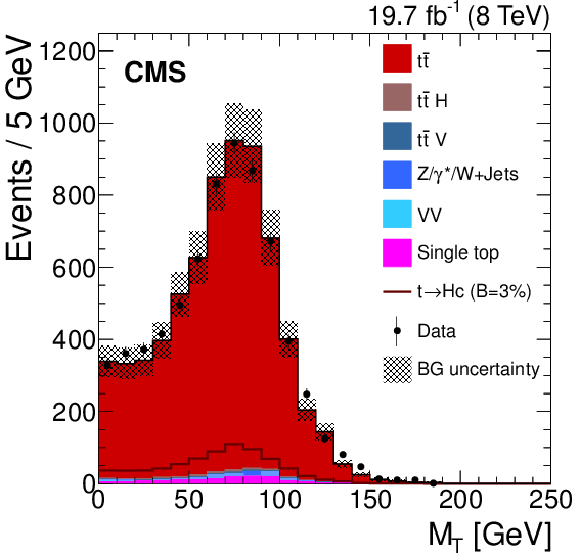
png pdf |
Figure 5-b:
Comparison between data and simulated events after the basic selection for b jet + lepton events has been applied: the reconstructed transverse mass of the W boson candidate. |

png pdf |
Figure 6:
The output distributions from the ANN discriminator for data (points) and simulated background (lines) where the ANN was trained to discriminate the backgrounds from either $\mathrm{ t } \to \mathrm{ H } \mathrm{c} $ (left) or $\mathrm{ t } \to \mathrm{ H } \mathrm{u} $ (right) decays. The solid line shows the result of the fit of the signal and background templates to data. The dotted line gives the predicted signal distribution from simulation for $\mathcal {B}(\mathrm{ t } \to \mathrm{ H } \mathrm{c} ) = $ 3% and the filled histogram shows the proportion of signal estimated from the fit. |
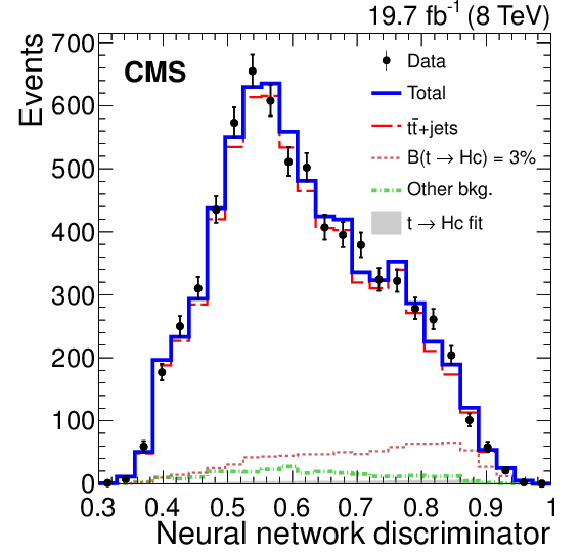
png pdf |
Figure 6-a:
The output distributions from the ANN discriminator for data (points) and simulated background (lines) where the ANN was trained to discriminate the backgrounds from $\mathrm{ t } \to \mathrm{ H } \mathrm{u} $ decays. The solid line shows the result of the fit of the signal and background templates to data. The dotted line gives the predicted signal distribution from simulation for $\mathcal {B}(\mathrm{ t } \to \mathrm{ H } \mathrm{c} ) = $ 3% and the filled histogram shows the proportion of signal estimated from the fit. |

png pdf |
Figure 6-b:
The output distributions from the ANN discriminator for data (points) and simulated background (lines) where the ANN was trained to discriminate the backgrounds from either $\mathrm{ t } \to \mathrm{ H } \mathrm{c} $ (left) or $\mathrm{ t } \to \mathrm{ H } \mathrm{u} $ (right) decays. The solid line shows the result of the fit of the signal and background templates to data. The dotted line gives the predicted signal distribution from simulation for $\mathcal {B}(\mathrm{ t } \to \mathrm{ H } \mathrm{c} ) = $ 3% and the filled histogram shows the proportion of signal estimated from the fit. |
| Tables | |

png pdf |
Table 1:
Summary of the requirements for the ${\rm pp \to {\mathrm{ t } {}\mathrm{ \bar{t} } } \to Hq + Wb}$ channels used in this analysis. |

png pdf |
Table 2:
Two-dimensional selection requirements on ${E_{\mathrm {T}}^{\text {miss}}}$ and ${H_{\mathrm {T}}}$ applied in the SS dilepton channel. An event is selected if it satisfies one of the three listed sets. |
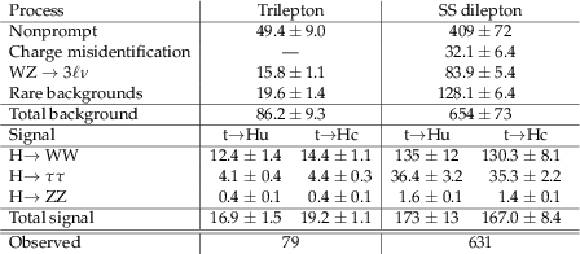
png pdf |
Table 3:
The predicted and observed inclusive event yields after the full event selection for the trilepton and SS dilepton categories assuming $\mathcal {B}({\rm t\rightarrow Hq}) = $ 1%. The quoted uncertainties include both statistical and systematic uncertainties added in quadrature. The total number of observed events is given in the last row. |

png pdf |
Table 4:
Observed event yield and the expected numbers of background and signal events for the diphoton selection in the hadronic and leptonic channels in the 100 $ < m_{\gamma \gamma } < $ 180 GeV mass range. The signal yields assume $\mathcal {B}(\mathrm{ t } \to \mathrm{ H } \mathrm{ q } ) = $ 1%. The uncertainties are statistical only. |

png pdf |
Table 5:
The expected number of background and signal events for the b jet + lepton selection from simulation. The signal yields from the simulation of the signal assume $\mathcal {B}(\mathrm{ t } \to \mathrm{ H } \mathrm{ q } ) = $ 1%. Uncertainties combine both statistical and systematic components in quadrature. |

png pdf |
Table 6:
The measured number of background and signal events for the b jet + lepton selection from fitting the ANN output trained on $\mathrm{ t } \to \mathrm{ H } \mathrm{c} $ and $\mathrm{ t } \to \mathrm{ H } \mathrm{u} $ final states. Uncertainties are statistical and systematic values, respectively. The observed number of events is shown in the last row. |

png pdf |
Table 7:
Systematic uncertainties for the $\rm t \bar{t} \to Hq + Wb $ (q = u, c) channels in percent. Ranges are quoted to indicate values that vary across the different analyses. |

png pdf |
Table 8:
The observed and expected upper limits at the 95% CL on the branching fraction (in %) of $\rm t \rightarrow Hq $ (q = u, c) for: trilepton, SS dilepton, and combined multilepton channels; diphoton; b jet + lepton; and the combination of all channels. For the expected upper limit, the limit plus and minus a standard deviation are also shown. |
| Summary |
| A search for flavor-changing neutral currents in the decay of a top quark to a charm or up quark and a Higgs boson based on $ \sqrt{s} = $ 8 TeV proton-proton collisions has been presented. Samples of multilepton, diphoton, and b jet + lepton events were selected from data recorded with the CMS detector, corresponding to an integrated luminosity of 19.7 fb$^{-1}$. The topologies ${\rm pp \to \mathrm{ t \bar{t} } \to}$ ${\rm Hq + Wb}$ events, where q = u, c and H is allowed to decay into WW, ZZ, $\tau \tau$, $\gamma\gamma$, and $\mathrm{ b \bar{b} }$. No excess of events above the SM background is observed, and branching fractions of ${\cal B}({\rm t \to Hc})$ larger than 0.40% and ${\cal B}({\rm t \to Hu})$ larger than 0.55% are excluded at the 95% confidence level. These upper limits are the most stringent ones published and provide the strongest constraints on top quark flavor-changing Higgs boson Yukawa couplings. |
| References | ||||
| 1 | ATLAS Collaboration | Observation of a new particle in the search for the Standard Model Higgs boson with the ATLAS detector at the LHC | PLB 716 (2012) 1 | 1207.7214 |
| 2 | CMS Collaboration | Observation of a new boson at a mass of 125 GeV with the CMS experiment at the LHC | PLB 716 (2012) 30 | CMS-HIG-12-028 1207.7235 |
| 3 | CMS Collaboration | Observation of a new boson with mass near 125 GeV in pp collisions at $ \sqrt{s} = $ 7 and 8 TeV | JHEP 06 (2013) 081 | CMS-HIG-12-036 1303.4571 |
| 4 | Particle Data Group, K. A. Olive et al. | Review of Particle Physics | CPC 38 (2014) 090001 | |
| 5 | M. Czakon, P. Fiedler, and A. Mitov | Total Top-Quark Pair-Production Cross Section at Hadron Colliders Through $ O(\alpha\frac{4}{S}) $ | PRL 110 (2013) 252004 | 1303.6254 |
| 6 | G. Eilam, J. L. Hewett, and A. Soni | Rare decays of the top quark in the standard and two Higgs doublet models | PRD 44 (1991) 1473 | |
| 7 | B. Mele, S. Petrarca, and A. Soddu | A new evaluation of the t$ \rightarrow $cH decay width in the standard model | PLB 435 (1998) 401 | hep-ph/9805498 |
| 8 | J. A. Aguilar-Saavedra | Top flavor-changing neutral interactions: Theoretical expectations and experimental detection | Acta Phys. Polon. B 35 (2004) 2695 | hep-ph/0409342 |
| 9 | ATLAS Collaboration | Search for top quark decays t $ \to $ qH with H $ \to \gamma\gamma $ using the ATLAS detector | JHEP 06 (2014) 008 | 1403.6293 |
| 10 | ATLAS Collaboration | Search for flavour-changing neutral current top quark decays $ t\to Hq $ in $ pp $ collisions at $ \sqrt{s}= $ 8 TeV with the ATLAS detector | JHEP 12 (2015) 061 | 1509.06047 |
| 11 | CMS Collaboration | Searches for heavy Higgs bosons in two-Higgs-doublet models and for t to ch decay using multilepton and diphoton final states in pp collisions at 8 TeV | PRD 90 (2014) 112013 | CMS-HIG-13-025 1410.2751 |
| 12 | LHC Higgs Cross Section Working Group | Handbook of LHC Higgs Cross Sections: 3. Higgs Properties | 1307.1347 | |
| 13 | A. Denner et al. | Standard model Higgs-boson branching ratios with uncertainties | EPJC 71 (2011) 1753 | 1107.5909 |
| 14 | CMS Collaboration | The CMS experiment at the CERN LHC | JINST 3 (2008) S08004 | CMS-00-001 |
| 15 | CMS Collaboration | Performance of Photon Reconstruction and Identification with the CMS Detector in Proton-Proton Collisions at $ \sqrt{s} = $ 8 TeV | JINST 10 (2015) P08010 | CMS-EGM-14-001 1502.02702 |
| 16 | CMS Collaboration | Particle--flow event reconstruction in CMS and performance for jets, taus, and $ E_{\mathrm{T}}^{\text{miss}} $ | CDS | |
| 17 | CMS Collaboration | Commissioning of the particle--flow event reconstruction with the first lhc collisions recorded in the cms detector | CDS | |
| 18 | S. Baffioni et al. | Electron reconstruction in CMS | EPJC 49 (2007) 1099 | |
| 19 | CMS Collaboration | Performance of CMS muon reconstruction in $ pp $ collision events at $ \sqrt{s}= $ 7 TeV | JINST 7 (2012) P10002 | CMS-MUO-10-004 1206.4071 |
| 20 | CMS Collaboration | Performance of electron reconstruction and selection with the CMS detector in proton-proton collisions at $ \sqrt{s} = $ 8 TeV | JINST 10 (2015) P06005 | CMS-EGM-13-001 1502.02701 |
| 21 | CMS Collaboration | Study of the mass and spin-parity of the Higgs boson candidate via its decays to Z boson pairs | PRL 110 (2013) 81803 | CMS-HIG-12-041 1212.6639 |
| 22 | CMS Collaboration | Energy calibration and resolution of the CMS electromagnetic calorimeter in $ pppp $ collisions at $ \sqrt{s} = 7 $ TeV | JINST 8 (2013) P09009 | CMS-EGM-11-001 1306.2016 |
| 23 | CMS Collaboration | Observation of the diphoton decay of the Higgs boson and measurement of its properties | EPJC 74 (2014) 3076 | CMS-HIG-13-001 1407.0558 |
| 24 | CMS Collaboration | Measurement of the inclusive $ W $ and $ Z $ production cross sections in pp collisions at $ \sqrt{s}= $ 7 TeV | JHEP 10 (2011) 132 | CMS-EWK-10-005 1107.4789 |
| 25 | M. Cacciari and G. P. Salam | Dispelling the $ N^{3} $ myth for the $ k_t $ jet-finder | PLB 641 (2006) 57 | hep-ph/0512210 |
| 26 | M. Cacciari and G. P. Salam | Pileup subtraction using jet areas | PLB 659 (2008) 119 | 0707.1378 |
| 27 | M. Cacciari, G. P. Salam, and G. Soyez | The Catchment Area of Jets | JHEP 04 (2008) 005 | 0802.1188 |
| 28 | M. Cacciari, G. P. Salam, and G. Soyez | FastJet User Manual | EPJC 72 (2012) 1896 | 1111.6097 |
| 29 | CMS Collaboration | Determination of jet energy calibration and transverse momentum resolution in CMS | JINST 6 (2011) 11002 | CMS-JME-10-011 1107.4277 |
| 30 | CMS Collaboration | Identification of b-quark jets with the CMS experiment | JINST 8 (2013) P04013 | CMS-BTV-12-001 1211.4462 |
| 31 | J. Alwall et al. | MadGraph 5: Going Beyond | JHEP 06 (2011) 128 | 1106.0522 |
| 32 | P. Nason | A new method for combining NLO QCD with shower Monte Carlo algorithms | JHEP 11 (2004) 040 | hep-ph/0409146 |
| 33 | S. Frixione et al. | Matching NLO QCD computations with parton shower simulations: the POWHEG method | JHEP 11 (2007) 070 | 0709.2092 |
| 34 | S. Alioli et al. | A general framework for implementing NLO calculations in shower Monte Carlo programs: the POWHEG BOX | JHEP 06 (2010) 043 | 1002.2581 |
| 35 | T. Sjostrand, S. Mrenna, and P. Skands | PYTHIA 6.4 physics and manual | JHEP 05 (2006) 026 | hep-ph/0603175 |
| 36 | Z. Was | TAUOLA the library for tau lepton decay, and KKMC / KORALB / KORALZ /... status report | NPPS 98 (2001) 96 | hep-ph/0011305 |
| 37 | T. Gleisberg et al. | Event generation with SHERPA 1.1 | JHEP 02 (2009) 007 | 0811.4622 |
| 38 | J. Reuter et al. | Modern Particle Physics Event Generation with WHIZARD | J. Phys. Conf. Ser. 608 (2015) 012063 | 1410.4505 |
| 39 | R. Field | Min-Bias and the Underlying Event at the LHC | Acta Phys. Polon. B 42 (2011) 2631 | 1110.5530 |
| 40 | H.-L. Lai et al. | Uncertainty induced by QCD coupling in the CTEQ global analysis of parton distributions | PRD 82 (2010) 054021 | 1004.4624 |
| 41 | P. M. Nadolsky et al. | Implications of CTEQ global analysis for collider observables | PRD 78 (2008) 013004 | 0802.0007 |
| 42 | GEANT4 Collaboration | GEANT4 -- a simulation toolkit | NIMA 506 (2003) 250 | |
| 43 | CMS Collaboration | Measurement of the differential cross section for top quark pair production in pp collisions at $ \sqrt{s} = $ 8 TeV | EPJC 75 (2015) 542 | CMS-TOP-12-028 1505.04480 |
| 44 | CMS Collaboration | Search for the associated production of the Higgs boson with a top-quark pair | JHEP 09 (2014) 087 | CMS-HIG-13-029 1408.1682 |
| 45 | CMS Collaboration | Measurement of the Drell-Yan cross section in pp collisions at $ \sqrt{s}= $ 7 TeV | JHEP 10 (2011) 007 | CMS-EWK-10-007 1108.0566 |
| 46 | R. C. Gray et al. | Backgrounds To Higgs Boson Searches from $ W \gamma^* \to l \nu l (l) $ Asymmetric Internal Conversion | 1110.1368 | |
| 47 | CMS Collaboration | Search for new physics with same-sign isolated dilepton events with jets and missing transverse energy at the LHC | JHEP 06 (2011) 077 | CMS-SUS-10-004 1104.3168 |
| 48 | CMS Collaboration | Search for new physics with same-sign isolated dilepton events with jets and missing transverse energy | PRL 109 (2012) 071803 | CMS-SUS-11-010 1205.6615 |
| 49 | CMS Collaboration | Search for the standard model Higgs boson decaying to $ W^{+}W^{-} $ in the fully leptonic final state in pp collisions at $ \sqrt{s}= $ 7 TeV | PLB 710 (2012) 91 | CMS-HIG-11-024 1202.1489 |
| 50 | CMS Collaboration | Search for the standard model Higgs boson decaying into two photons in pp collisions at $ \sqrt{s}= $ 7 TeV | PLB 710 (2012) 403 | CMS-HIG-11-033 1202.1487 |
| 51 | H. Voss, A. Hocker, J. Stelzer, and F. Tegenfeldt | TMVA, the toolkit for multivariate data analysis with ROOT | in XIth International Workshop on Advanced Computing and Analysis Techniques in Physics Research (ACAT) 2007 | physics/0703039 |
| 52 | CMS Collaboration | Cms luminosity based on pixel cluster counting - summer 2013 update | CMS-PAS-LUM-13-001 | CMS-PAS-LUM-13-001 |
| 53 | CMS Collaboration | Measurement of the $ \mathrm{ t \bar{t} } $ production cross section in pp collisions at $ \sqrt{s} = $ 8 TeV in dilepton final states containing one $ \tau $ lepton | PLB 739 (2014) 23 | CMS-TOP-12-026 1407.6643 |
| 54 | D. Bourilkov, R. C. Group, and M. R. Whalley | LHAPDF: PDF use from the Tevatron to the LHC | in TeV4LHC Workshop - 4th meeting Batavia, Illinois, 2005 | hep-ph/0605240 |
| 55 | M. V. Garzelli, A. Kardos, C. G. Papadopoulos, and Z. Trocsanyi | $ \mathrm{ t \bar{t} } \mathrm{W}^{\pm} $ and $ \mathrm{ t \bar{t} } $ Z hadroproduction at NLO accuracy in QCD with parton shower and hadronization effects | JHEP 11 (2012) 056 | 1208.2665 |
| 56 | LHC Higgs Cross Section Working Group Collaboration | Handbook of LHC Higgs Cross Sections: 1. Inclusive Observables | 1101.0593 | |
| 57 | T. Junk | Confidence level computation for combining searches with small statistics | NIMA 434 (1999) 435 | hep-ex/9902006 |
| 58 | A. L. Read | Presentation of search results: the $ CL_s $ technique | JPG 28 (2002) 2693 | |
| 59 | G. Cowan, K. Cranmer, E. Gross, and O. Vitells | Asymptotic formulae for likelihood-based tests of new physics | EPJC 71 (2011) 1554 | 1007.1727 |
| 60 | N. Craig et al. | Searching for t $ \to $ ch with Multi-Leptons | PRD 86 (2012) 075002 | 1207.6794 |
| 61 | D. Atwood, S. K. Gupta, and A. Soni | Constraining the flavor changing Higgs couplings to the top-quark at the LHC | JHEP 10 (2014) 057 | 1305.2427 |
| 62 | A. Denner and T. Sack | The top width | NPB 358 (1991) 46 | |

|
Compact Muon Solenoid LHC, CERN |

|

|

|

|

|

|